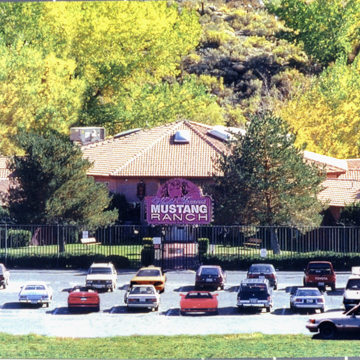Since the mid-nineteenth century, brothels have been a part of Nevada's built environment. In a state where the main industries, mining and ranching, were dominated by men, prostitution developed quickly. Until the federal government shut it down in the summer of 1999, the Mustang Ranch was Nevada's largest, most elaborate, and most notorious brothel. Once visitors leave the interstate and cross the Truckee River to the south, they have entered Storey County, where prostitution is legal. The former brothel stands in an isolated area surrounded by a high metal fence and gate. Two other former brothels are nearby.
Despite its hot-pink paint, the Mustang Ranch resembles a low-security prison. Built of concrete blocks with stucco on the exterior walls, the structure has a central circular section with radiating wings of bedrooms extending to the sides and rear, a plan reminiscent of a panopticon. A guard tower above the complex allows surveillance of the approaching roads and the brothel yard. Such security measures provided a means to control clients' access. A large parking lot in front of the “ranch” accommodated cars, trucks, and tractor trailers. Only customers were permitted inside. The entrance led to a parlor that served as a waiting area for clients. From there, hallways led to small bedrooms. Other spaces housed facilities for the prostitutes, including a cafeteria, a communal kitchen, and a hair salon. A branch next door, the Mustang II, provided additional accommodations in a warren of trailers.
Legalized prostitution in the state is highly regulated. The women must undergo weekly health examinations by doctors. They work as independent contractors, paying for their room and board in compounds such as the Mustang Ranch. Usually they work ten- to fourteen-hour-a-day shifts for three weeks, with one week off. During the three-week shift they cannot leave the compound.
Joe Conforte established the ranch here in the 1960s, housing the business in trailers. Its economic success and Conforte's influence persuaded the Storey County commissioners to legalize prostitution in 1971. Conforte operated the ranch until 1990, when the Internal Revenue Service seized it because of unpaid taxes. Ironically, the federal government operated the brothel for a few days until it was auctioned. The Mustang Ranch continued to be very profitable until the federal government closed it for a second time after the owners were convicted of fraud and racketeering. In another strange twist, the Bureau of Land Management considered converting the structure into an interpretive center for its Wild Horse and Burro Adoption Center.
In 2002, brothel owner and real estate developer Lance Gilman purchased the Mustang Ranch from the Bureau of Land Management for $145,100 on eBay. The following year, he moved the buildings via helicopter five miles west to the site of his extant brothel, the Wild Horse Adult Resort and Spa. In 2005, the Mustang Ranch reopened at this new location, its buildings modernized but retaining the lavish interior decor and original exterior sign. Six years later, the Wild Horse Resort closed, leaving the Mustang Ranch as the only brothel on the site.
References
Albert, Alexa. Brothel: Mustang Ranch and Its Women. New York: Ballantine Books, 2002.
Associated Press. "Nevada's Most Infamous Brothel, Mustang Ranch, Back In Business." Fox News, August 5, 2007.
Gardner, Tom. "Infamous Mustang Ranch Brothel Revived." The Oklahoman, August 11, 2007.

